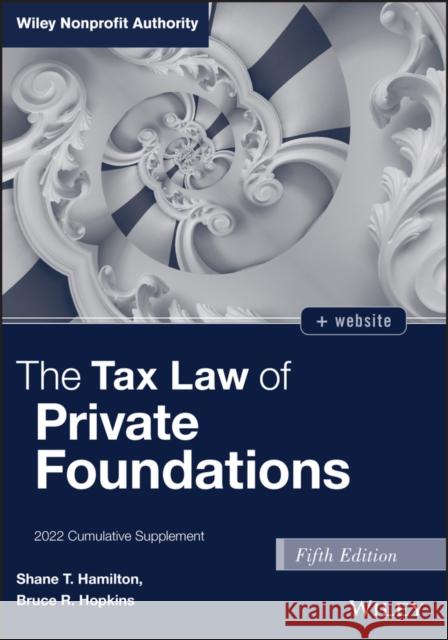The Tax Law of Private Foundations: 2022 Cumulative Supplement » książka



The Tax Law of Private Foundations: 2022 Cumulative Supplement
ISBN-13: 9781119930266 / Angielski / Miękka / 2022
The Tax Law of Private Foundations: 2022 Cumulative Supplement
ISBN-13: 9781119930266 / Angielski / Miękka / 2022
(netto: 560,05 VAT: 5%)
Najniższa cena z 30 dni: 584,43
ok. 30 dni roboczych
Dostawa w 2026 r.
Darmowa dostawa!
Preface ixBook Citations xi1 Introduction to Private Foundations 1 1.1 Private Foundations: Unique Organizations 1 1.2 Definition of Private Foundation 2 1.4 Private Foundation Law Primer 2 1.5 Foundations in Overall Exempt Organizations Context 2 1.6 Definition of Charity 2 1.7 Operating for Charitable Purposes 3 1.9 Private Foundation Sanctions 3 1.10 Statistical Profile 12 1.11 Private Foundations and Law 50 Years Later 122 Starting, Funding, and Governing a Private Foundation 17 2.1 Choice of Organizational Form 17 2.3 Estate Planning Principles 17 2.4 Foundations and Planned Giving 17 2.5 Acquiring Recognition of Tax-Exempt Status 18 2.6 Special Requirements for Charitable Organizations 19 2.7 When to Report Back to the IRS 193 Types of Private Foundations 21 3.1 Private Operating Foundations 21 3.3 Conduit Foundations 22 3.4 Common Fund Foundations 23 3.8 Split-Interest Trusts 23 3.9 Foreign Private Foundations 234 Disqualified Persons 25 4.1 Substantial Contributors 25 4.2 Foundation Managers 25 4.3 Certain 20 Percent Owners 25 4.4 Family Members 26 4.5 Corporations or Partnerships 26 4.6 Trusts or Estates 265 Self-Dealing 27 5.1 Private Inurement Doctrine 27 5.2 Private Benefit Doctrine 28 5.3 Definition of Self-Dealing 31 5.3a Excess Compensation Tax 31 5.4 Sale, Exchange, Lease, or Furnishing of Property 37 5.5 Loans and Other Extensions of Credit 37 5.6 Payment of Compensation 38 5.8 Uses of Income or Assets by Disqualified Persons 39 5.11 Indirect Self-Dealing 42 5.12 Property Held by Fiduciaries 50 5.14 Additional Exceptions 58 5.15 Issues Once Self-Dealing Occurs 596 Mandatory Distributions 65 6.1 Distribution Requirements--in General 65 6.2 Assets Used to Calculate Minimum Investment Return 66 6.3 Determining Fair Market Value 66 6.4 Distributable Amount 69 6.5 Qualifying Distributions 70 6.7 Satisfying the Distribution Test 757 Excess Business Holdings 77 7.1 General Rules 77 7.2 Permitted and Excess Holdings 79 7.3 Functionally Related Businesses 80 7.7 Excise Taxes on Excess Holdings 808 Jeopardizing Investments 81 8.2 Prudent Investments 81 8.3 Program-Related Investments 81 8.4 Investment Frauds 82 8.5 Excise Tax for Jeopardizing Investments 829 Taxable Expenditures 83 9.1 Legislative Activities 83 9.2 Political Campaign Activities 84 9.3 Grants to Individuals 84 9.4 Grants to Public Charities 97 9.6 Grants to Foreign Organizations 97 9.7 Expenditure Responsibility 99 9.8 Internet and Private Foundations 100 9.9 Spending for Noncharitable Purposes 100 9.10 Distributions to Certain Supporting Organizations 102 9.10a Distributions to Group Exemption Organizations 102 9.11 Excise Tax for Taxable Expenditures 10410 Tax on Investment Income 107 10.1 Rate of Tax 107 10.1A Payment of Tax 107 10.2 Reducing Excise Tax 108 10.3 Formula for Taxable Income 109 10.4 Reductions to Gross Investment Income 109 10.5 Foreign Foundations 109 10.6 Exemption from Tax on Investment Income 11011 Unrelated Business Activity 111 11.1 General Rules 111 11.2 Exceptions 111 11.3 Rules Specifically Applicable to Private Foundations 112 11.4 Unrelated Debt-Financed Income Rules 113 11.5 Calculating and Reporting the Tax 11412 Tax Compliance and Administrative Issues 121 12.1 Form 990-PF 121 12.2 Form 990-PF Penalties 124 12.3 Automatic Revocation for Non-Filing 128 12.4 Public Disclosure and Inspection of Returns 129 12.5 Reporting and Payment of Excise Taxes 13213 Termination of Foundation Status 145 13.1 Voluntary Termination 145 13.3 Transfer of Assets to a Public Charity 146 13.4 Operation as a Public Charity 147 13.5 Mergers, Split-Ups, and Transfers Between Foundations 150 13.5A Termination of Trusts Treated as Private Foundations 15014 Charitable Giving Rules 153 14.1 Concept of Gift 153 14.2 Basic Rules 154 14.3 Gifts of Appreciated Property 155 14.4 Deductibility of Gifts to Foundations 155 14.5 Qualified Appreciated Stock Rule 155 14.6 Deduction Reduction Rules 155 14.7 Special Gift Situations 156 14.8 Planned Giving Revisited 156 14.9 Administrative Considerations 15615 Private Foundations and Public Charities 163 15.1 Distinctions Between Public and Private Charities 163 15.2 Evolution of Law of Private Foundations 164 15.3 Organizations with Inherently Public Attributes 164 15.4 Publicly Supported Organizations--Donative Entities 166 15.5 Service Provider Organizations 167 15.7 Supporting Organizations 169 15.8 Change of Public Charity Category 169 15.9 Noncharitable Supported Organizations 171 15.14 Termination of Public Charity Status 17216 Donor-Advised Funds 173 16.1 Basic Definitions 173 16.3 Types of Donor Funds 173 16.7 Public Charity Status of Funds 173 16.8 Interrelationship of Private Foundation Rules 173 16.9 Statutory Criteria 173 16.9A Litigation 174 16.12 Tax Regulations 176 16.13 DAF Statistical Portrait 176 16.14 Criticisms and Commentary 178 16.15 Proposed Legislation 18517 Corporate Foundations 189 17.2 Reasons for Establishment of a Corporate Foundation 189 17.3 Private Inurement Doctrine 189 17.3A Private Benefit Doctrine 189 17.5 Self-Dealing Rules 190 17.6 Other Private Foundations Rules 191 17.7 Tax on Excess Compensation: Potentially Applicable Exceptions Illustrated 191Appendix A--Sources of the Law 197Appendix B--Internal Revenue Code Sections 223Table of Cases 227Table of IRS Revenue Rulings and Revenue Procedures 233Table of IRS Private Determinations Cited in Text 237Table of IRS Private Letter Rulings, Technical Advice Memoranda, and General Counsel Memoranda 245About the Authors 263About the Online Resources 265Cumulative Index 267
1997-2025 DolnySlask.com Agencja Internetowa
KrainaKsiazek.PL - Księgarnia Internetowa









